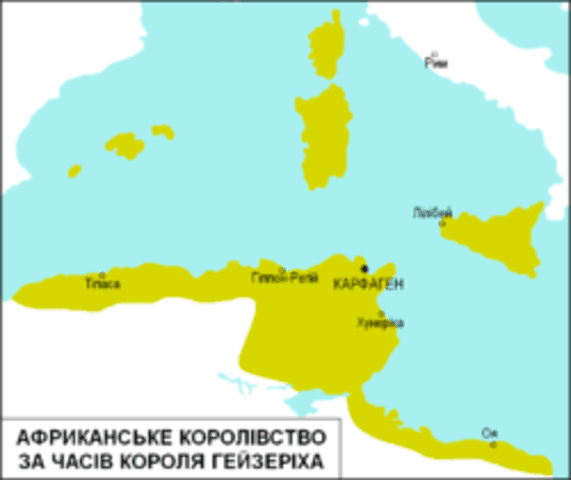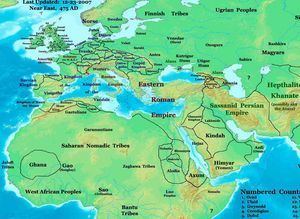Government Pre-feudal Monarchy | 435–477 Genseric Founded 435 AD | |
 | ||
Languages Latin (spoken by elite and clergy)Vulgar Latin and African Romance (spoken by common people)Vandalic (spoken among elite)Punic (spoken among common people)Numid (spoken among common people in rural areas)Medieval Greek (spoken among common people) Religion Arianism (among elite)Nicene Christianitythen Chalcedonian Christianity | ||
Vandal kingdom
The Vandal Kingdom (Latin: Regnum Vandalum) or Kingdom of the Vandals and Alans (Latin: Regnum Vandalorum et Alanorum) was a kingdom established by the Germanic Vandals under Gaiseric in North Africa and the Mediterranean from 435 AD to 534 AD. It was originally created by the settlement of the Vandals in the province of Numidia and Mauretania by the Roman government and then extended by conquest further into North Africa and the Mediterranean. The Kingdom was conquered by Byzantine Emperor Justinian in the Vandalic War.
Contents
- Vandal kingdom
- Establishment
- Sack of Rome
- Later years
- Conquest by the Eastern Roman Empire
- Religion
- List of kings
- References

Although primarily remembered for their persecution of orthodox Nicene Christians, the Vandals were also patrons of learning. Grand building projects continued, schools flourished and North Africa fostered many of the most innovative writers and natural scientists of the late Latin West.

Establishment
The Vandals, under their new king Genseric (also known as Geiseric), crossed to Africa in 429. Although numbers are unknown and some historians debate the validity of estimates, based on Procopius' assertion that the Vandals and Alans numbered 80,000 when they moved to North Africa, Peter Heather estimates that they could have fielded an army of around 15,000–20,000. According to Procopius, the Vandals came to Africa at the request of Bonifacius, the military ruler of the region. However, it has been suggested that the Vandals migrated to Africa in search of safety; they had been attacked by a Roman army in 422 and had failed to seal a treaty with them. Advancing eastwards along the coast, the Vandals laid siege to the walled city of Hippo Regius in 430. Inside, Saint Augustine and his priests prayed for relief from the invaders, knowing full well that the fall of the city would spell conversion or death for many Roman Christians. On 28 August 430, three months into the siege, St. Augustine (who was 75 years old) died, perhaps from starvation or stress, as the wheat fields outside the city lay dormant and unharvested. After 14 months, hunger and the inevitable diseases were ravaging both the city inhabitants and the Vandals outside the city walls, with the city eventually falling to the Vandals, who made it their first capital.

Peace was made between the Romans and the Vandals in 435 through a treaty giving the Vandals control of coastal Numidia and parts of Mauretania. Geiseric chose to break the treaty in 439 when he invaded the province of Africa Proconsularis and laid siege to Carthage. The city was captured without a fight; the Vandals entered the city while most of the inhabitants were attending the races at the hippodrome. Genseric made it his capital, and styled himself the King of the Vandals and Alans, to denote the inclusion of his Alan allies into his realm. Conquering Sicily, Sardinia, Corsica, Malta and the Balearic Islands, he built his kingdom into a powerful state. Historian Cameron suggests that the new Vandal rule may not have been unwelcome to the population of North Africa as the previous landowners were generally unpopular.
The impression given by sources such as Victor of Vita, Quodvultdeus, and Fulgentius of Ruspe was that the Vandal take-over of Carthage and North Africa led to widespread destruction. However, recent archaeological investigations have challenged this assertion. Although Carthage's Odeon was destroyed, the street pattern remained the same and some public buildings were renovated. The political centre of Carthage was the Byrsa Hill. New industrial centres emerged within towns during this period. Historian Andy Merrills uses the large amounts of African Red Slip ware discovered across the Mediterranean dating from the Vandal period of North Africa to challenge the assumption that the Vandal rule of North Africa was a time of economic instability. When the Vandals raided Sicily in 440, the Western Roman Empire was too preoccupied with war in Gaul to react. Theodosius II, emperor of the Eastern Roman Empire, dispatched an expedition to deal with the Vandals in 441, however it only progressed as far as Sicily. The Western Empire under Valentinian III secured peace with the Vandals in 442. Under the treaty the Vandals gained Byzacena, Tripolitania, part of Numidia, and confirmed their control of Proconsular Africa.
Sack of Rome
During the next thirty-five years, with a large fleet, Genseric looted the coasts of the Eastern and Western Empires. After Attila the Hun's death, however, the Romans could afford to turn their attention back to the Vandals, who were in control of some of the richest lands of their former empire.
In an effort to bring the Vandals into the fold of the Empire, Valentinian III offered his daughter's hand in marriage to Genseric's son. Before this treaty could be carried out, however, politics again played a crucial part in the blunders of Rome. Petronius Maximus, the usurper, killed Valentinian III in an effort to control the Empire. Diplomacy between the two factions broke down, and in 455 with a letter from the Empress Licinia Eudoxia, begging Genseric's son to rescue her, the Vandals took Rome, along with the Empress Licinia Eudoxia and her daughters Eudocia and Placidia.
The chronicler Prosper of Aquitaine offers the only fifth-century report that on 2 June 455, Pope Leo the Great received Genseric and implored him to abstain from murder and destruction by fire, and to be satisfied with pillage. Whether the pope's influence saved Rome is, however, questioned. The Vandals departed with countless valuables. Eudoxia and her daughter Eudocia were taken to North Africa.
Later years
As a result of the Vandal sack of Rome and piracy in the Mediterranean, it became important to the Roman Empire to destroy the Vandal kingdom. In 460, Western Roman Emperor Majorian attempted to invade the Vandal Kingdom, but he was defeated in a naval battle in Cartagena, Spain. In 468, both the Western and Eastern empires attempted to conquer again, with a force of more than 100,000 men. At a naval battle in Cape Bon, Tunisia, the Vandals destroyed the Western fleet and part of the Eastern through the use of fire ships. Following up the attack, the Vandals tried to invade the Peloponnese, but were driven back by the Maniots at Kenipolis with heavy losses. In retaliation, the Vandals took 500 hostages at Zakynthos, hacked them to pieces and threw the pieces overboard on the way to Carthage. In the 470s, the Romans abandoned their policy of war against the Vandals. The Western Germanic general Ricimer reached a treaty with the Vandals, and in 476 Genseric was able to conclude a "perpetual peace" with Constantinople. Relations between the two states assumed a veneer of normality. From 477 onwards, the Vandals produced their own coinage. It was restricted to bronze and silver low-denomination coins. Although the low-denomination imperial money was replaced, the high-denomination was not, demonstrating in the words of Merrills "reluctance to usurp the imperial prerogative".
Genseric died on 25 January 477, at the great age of around 88 years. According to the law of succession which he had promulgated, the oldest male member of the royal house was to succeed. Thus he was succeeded by his son Huneric (477–484), who at first tolerated Nicene Christians, owing to his fear of Constantinople, but after 482 began to persecute Manichaeans and Nicene Christians."
Gunthamund (484–496), his cousin and successor, sought internal peace with the Nicene Christians and ceased persecution once more. Externally, the Vandal power had been declining since Genseric's death, and Gunthamund lost large parts of Sicily to Theodoric's Ostrogoths and had to withstand increasing pressure from the native Berbers.
Gunthamund's successor Thrasamund (496–523), owing to his religious fanaticism, was hostile to Nicene Christians, but contented himself with bloodless persecutions.
Conquest by the Eastern Roman Empire
Thrasamund's successor Hilderic (523–530) was the Vandal king most tolerant towards the trinitarian Christian Church. He granted it religious freedom; consequently Catholic synods were once more held in North Africa. However, he had little interest in war, and left it to a family member, Hoamer. When Hoamer suffered a defeat against the Berbers, the Arian faction within the royal family led a revolt, and his cousin Gelimer (530–533) became king. Hilderic, Hoamer and their relatives were thrown into prison. Hilderic was deposed and murdered in 533.
Byzantine Emperor Justinian I declared war, with the stated intention of restoring Hilderic to the Vandal throne. While an expedition was en route, a large part of the Vandal army and navy was led by Tzazo, Gelimer's brother, to Sardinia to deal with a rebellion by the Gothic nobleman Godas. As a result, the armies of the Byzantine Empire commanded by Belisarius were able to land unopposed 10 miles (16 km) from Carthage. Gelimer quickly assembled an army, and met Belisarius at the Battle of Ad Decimum; the Vandals were winning the battle until Gelimer's brother Ammatas and nephew Gibamund fell in battle. Gelimer then lost heart and fled. Belisarius quickly took Carthage while the surviving Vandals fought on.
On December 15, 533, Gelimer and Belisarius clashed again at the Battle of Tricamarum, some 20 miles (32 km) from Carthage. Again, the Vandals fought well but broke, this time when Gelimer's brother Tzazo fell in battle. Belisarius quickly advanced to Hippo, second city of the Vandal Kingdom, and in 534 Gelimer, besieged in Mount Pappua by the Herulian General Pharas, surrendered to the Byzantines, ending the Kingdom of the Vandals.
North Africa (which is north Tunisia and eastern Algeria in the period of the Vandals) became a Byzantine province, from which the Vandals were expelled. Many Vandals went to back Saldae (which is called today Béjaïa north Algeria) where they integrated themselves with the Berbers. Many others were put into imperial service or fled to the two Gothic kingdoms (Ostrogothic Kingdom and Visigothic kingdom), some Vandal women married Byzantine soldiers settled in north Algeria and Tunisia. The best Vandal warriors were formed into five cavalry regiments, known as Vandali Iustiniani, and stationed on the Persian frontier. Some entered the private service of Belisarius. Gelimer himself was honourably treated and received large estates in Galatia where he lived to be an old man. He was also offered the rank of a patrician but had to refuse it because he was not willing to change his Arian faith". In the words of historian Roger Collins: "The remaining Vandals were then shipped back to Constantinople to be absorbed into the imperial army. As a distinct ethnic unit they disappeared".
Religion
Differences the Arian Vandals and their Trinitarian subjects (including both Catholics and Donatists) were a constant source of tension in their African state. Catholic bishops were exiled or killed by Genseric. Laymen were excluded from office and frequently suffered confiscation of their property. He protected his Catholic subjects when his relations with Rome and Constantinople were friendly, as during the years 454–57, when the Catholic community at Carthage, being without a head, elected Deogratias bishop. The same was also the case during the years 476–477 when Bishop Victor of Cartenna sent him, during a period of peace, a sharp refutation of Arianism and suffered no punishment. Huneric, Genseric's successor, issued edicts against Catholics in 483 and 484 in an effort to marginalise them and make Arianism the primary religion in North Africa. Generally most Vandal kings, except Hilderic, persecuted Trinitarian Christians to a greater or lesser extent, banning conversion for Vandals, exiling bishops and generally making life difficult for Trinitarians.
